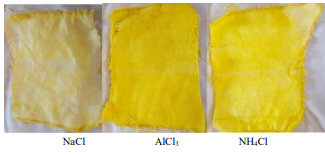Extraction, Characterization and Application of Dye from Curcuma longa
Keywords:
Turmeric, Curcuma longa, Colourant, MordantsAbstract
The colourant in turmeric rhizome (Curcuma longa) was extracted using the solvent extraction method and characterized using UV/Visible spectroscopy to determine its absorbance against wavelength. The UV/Visible analysis confirmed that the colourant absorbs strongly in the yellow region of the visible range of the electromagnetic spectrum. Physico-chemical properties such as melting point and its solubility in different solvents were determined. The dye extract was also tested on cotton and wool fabrics using three salts, such as aluminium chloride, sodium chloride and ammonium chloride, as mordants. The result revealed that Curcuma longa is most suitable for dyeing wool fabric. When aluminum chloride was used as mordant for dye fixation the hue produced was more deep than the other two mordants tested. The colourant was also applied to personal care product such as body cream and the result obtained showed that the concentration of the colourant employed determines the strength of the hue in the product
References
M.L. Gulrajani, “Present status of natural dyes” Book of papers of the convention on natural dyes. Vol. 5, Issue 3, 1999.
A. Mukherji, “Dyeing of Cotton Fabric with Kigelia Pinnata, SpathodeaCompanulata and Carissa Congesta” Book of Papers of the Convention onNatural Dyes. Vol. 4, Issue 2, 1999.
S. Naz and A. Bhatti, “Dyeing properties of cotton fabric using un-irradiated and gamma irradiated extracts of Eucalyptus camaldulensis bark powder” Indian Journal of Fibre and Textile Research, Vol. 36, Issue 2, pp.132–146, 2011
O. Deveoglu, E. Torgan, and R. Karadag, “High-performance liquid chromatography of some natural dyes: analysis of plant extracts and dyed textile” Color Technology, Vol. 128 pp.133–138, 2012
P.S. Vankar, “The Chemistry of Natural dyes” General Resonance, India pp. 73-80, 2000
N. Bhattacharyya, “Natural dyes and their eco-friendly application” IAFL, New Delhi.
O. Deveouglu, “Natural Dye Researcher” Marmara University, In press, Accessed 16th July 2017.
A. K. Samanta and P. Agarwal, “Application of natural dyes in textiles” Indian Journal of Fibre and Textile Research, Vol. 34 Issue 4 pp.384–399, 2009.
M. Grieve and C. F. Leyel “A Modern Herbal: The Medical, Culinary, Cosmetic and Economic Properties, Cultivation and Folklore of Herbs, Grasses, Fungi, Shrubs and Trees with all of their Modern Scientific Uses” New York: Barnesand Noble Publishing,1992.
A. I. Vogel, A. R. Tatchell, B. S. Furnis, A. J. Hannaford and P. W. G. Smith “Vogel`s Textbook of Practical Organic Chemistry (5th ed.)” 1978
P. Singh, “Green Synthesis and Characterization of Silver Nanoparticles by using Aloe Vera plant extract” International Journal of Scientific Research in Chemical Science, Vol. 6 Issue 3 pp.1-3, 2019

Downloads
Published
How to Cite
Issue
Section
License
Copyright (c) 2024 D. B. Lene, M. A. Adebayo, L. A. Ogunfowora

This work is licensed under a Creative Commons Attribution 4.0 International License.
Authors contributing to this journal agree to publish their articles under the Creative Commons Attribution 4.0 International License, allowing third parties to share their work (copy, distribute, transmit) and to adapt it, under the condition that the authors are given credit and that in the event of reuse or distribution, the terms of this license are made clear.





